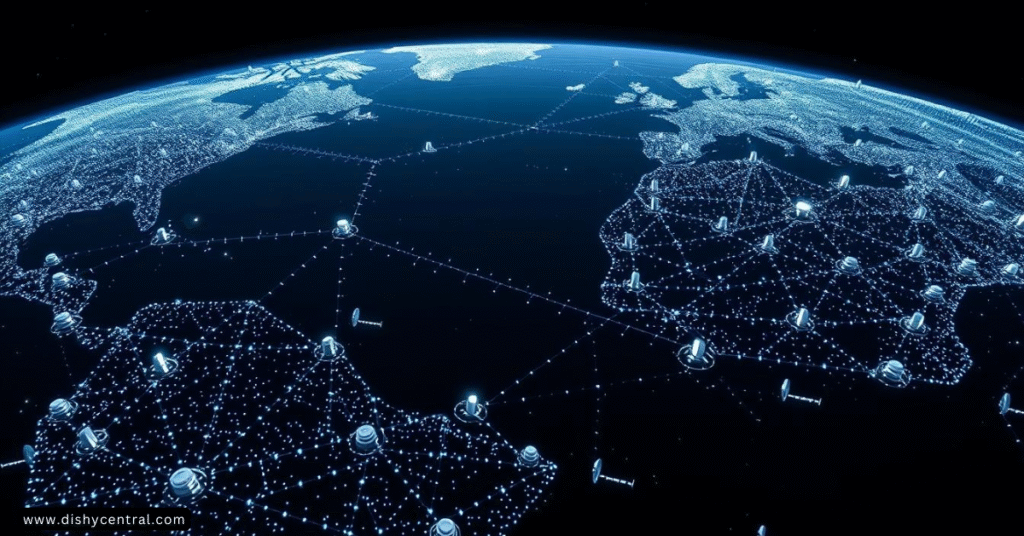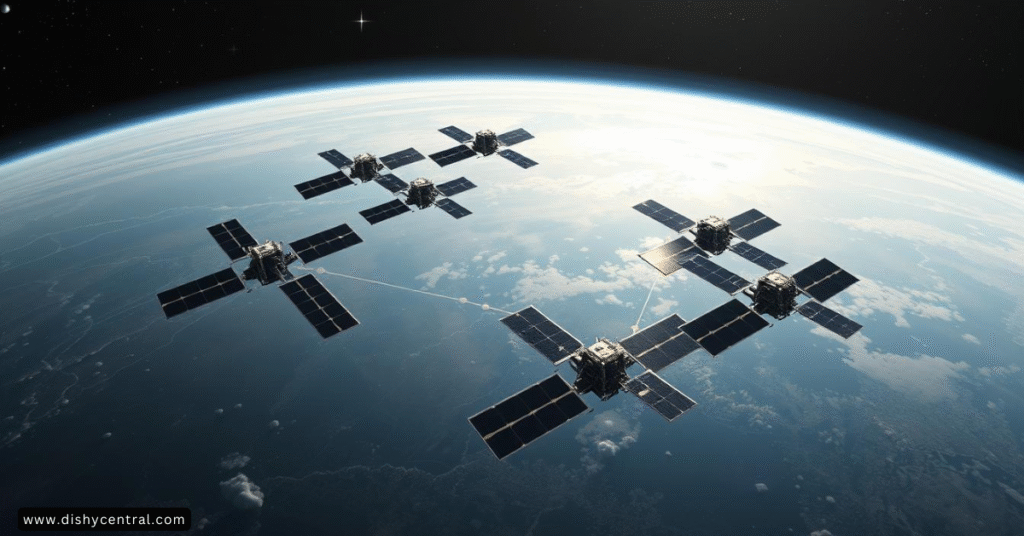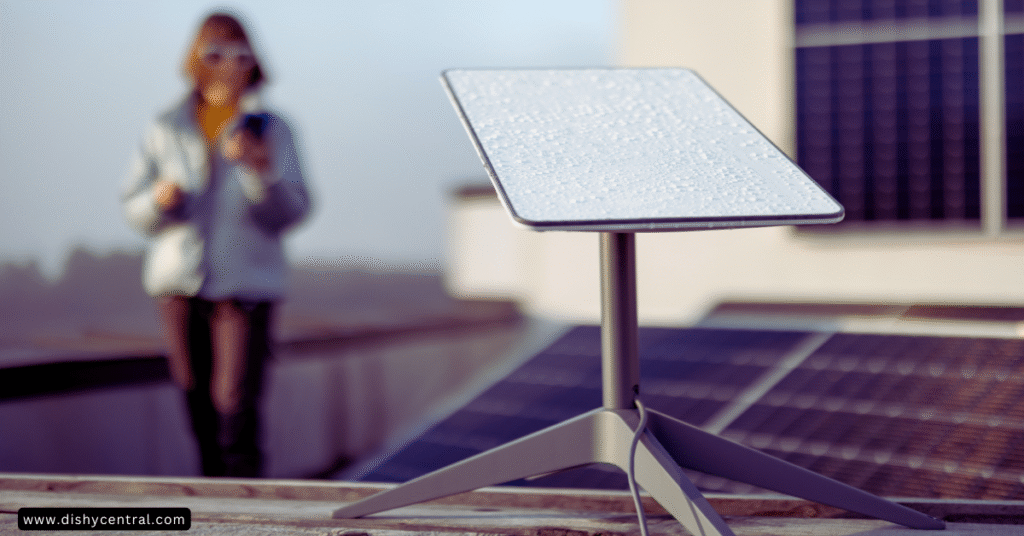How does Starlink work? Can a satellite internet system change how we connect around the world? As we rely more on high-speed internet, the need for global access is urgent.
I’m excited to look into Starlink technology and how it’s closing the connectivity gap. It uses a network of low-Earth orbit satellites to bring global connectivity to remote places.This big project wants to give everyone fast, reliable, and cheap internet. As we explore Starlink, we’ll see what it can do for our lives.
Key Takeaways
- Starlink technology uses a constellation of low-Earth orbit satellites to provide global connectivity.
- High-speed internet is becoming increasingly essential for daily life.
- Starlink aims to deliver fast, reliable, and affordable internet access worldwide.
- The technology has the ability to bridge the connectivity gap in remote areas.
- Starlink’s innovative approach is revolutionizing the satellite internet landscape.
The Starlink Revolution in Global Internet Access
SpaceX’s Starlink is leading a big change in how we connect online. The world needs fast, reliable internet for work, school, and life. This need is more urgent than ever.

SpaceX’s Vision for Universal Connectivity
SpaceX wants to make sure everyone can get online fast, no matter where they are. They’re using a network of satellites to do this. This plan aims to cover even the most hard-to-reach places.
With new satellite tech, SpaceX is working to close the gap in internet access. This will open up new chances for people all over the world.
The Problem of Digital Divide in Remote Areas
The digital divide is when some people can’t get online like others. Remote areas often struggle the most because they lack good internet.
Starlink is trying to fix this with satellite internet. They want to make sure everyone can get online, no matter where they live. This will help close the digital divide.
The Starlink Satellite Constellation Architecture
SpaceX is changing how we access the internet with the Starlink satellite constellation.

Low Earth Orbit Advantages Over Geostationary Satellites
The Starlink constellation operates in low Earth orbit, about 550 kilometers up. This is much lower than geostationary satellites, which are around 36,000 kilometers away.
This lower orbit cuts down on signal delay and boosts network speed. Geostationary satellites have longer signal paths, leading to higher latency.
Current Deployment Status and Future Expansion Plans
SpaceX has made big strides in launching the Starlink constellation. With many launches, the company is growing its network. This makes it better at providing internet all over the world.
Looking ahead, SpaceX plans to launch more satellites. This will keep the network strong and ready for more users.
How Does Starlink Work: The Technical Breakdown
Exploring Starlink’s tech shows it uses advanced tech for fast, reliable internet worldwide. Its design is key to understanding how it works.
Phased Array Antenna Technology
The “Dishy McFlatface” uses phased array antenna technology. This tech steers beams electronically, without moving parts. It makes communication more reliable and efficient.
The benefits of phased array antenna technology include:
- Improved signal strength and quality
- Enhanced reliability due to fewer moving parts
- Faster beam steering for better performance
Laser Inter-Satellite Links
Laser inter-satellite links are another key part of Starlink. They let satellites talk to each other directly. This cuts down on latency and boosts network efficiency.
The advantages of laser inter-satellite links include:
- Reduced latency due to fewer hops
- Improved network resilience through multiple paths
- Enhanced data transfer speeds
Ground Station Communication Systems
Starlink’s ground station communication systems are the last piece. These stations connect the satellite network to the internet. They handle data transfer between satellites and users.
Key aspects of ground station communication systems include:
- Strategic location to maximize coverage and minimize latency
- Advanced equipment for efficient data transfer
- Integration with existing internet backbone infrastructure
Starlink’s success comes from its use of phased array antennas, laser links, and ground stations. Together, they form a powerful network for global internet access.
The Starlink User Hardware Components
At the heart of the Starlink experience are its advanced user hardware components. They are designed to deliver high-speed internet access to users worldwide. The user hardware is key for connecting to the Starlink satellite constellation.
Starlink user hardware includes two main parts: the user terminal and the router. The user terminal, also known as “Dishy McFlatface,” is a phased array antenna. It talks to the Starlink satellites. This tech makes data transmission fast and reliable.
Dishy McFlatface: The Advanced User Terminal
The “Dishy McFlatface” user terminal is a sophisticated device. It’s compact, durable, and easy to use. It automatically adjusts to get the best signal from the Starlink satellites.
The user terminal’s phased array technology lets it steer the beam electronically. This means no mechanical movement is needed. It makes the connection more reliable and efficient.
Router Specifications and Network Setup
The Starlink router works well with the user terminal. It provides a strong and secure network setup. The router has dual-band Wi-Fi and Gigabit Ethernet ports for fast connectivity.
Setting up the Starlink network is easy. Just connect the router to the user terminal and follow the on-screen instructions. The setup is designed to be simple, so anyone can start using Starlink quickly.
Behind the Scenes: Starlink’s Ground Infrastructure
Starlink’s success relies on a complex network of ground infrastructure. This setup is key for smooth internet access around the world.
Starlink’s ground infrastructure has several important parts. They work together to give users fast internet.
Global Network of Ground Stations
Starlink has a global network of ground stations. These stations talk to its satellites. They are placed to cover the most area and connect to the internet backbone.
These stations are essential. They keep the network strong by linking satellites to the internet.
Data Centers and Internet Backbone Integration
Starlink’s data centers are vital. They manage and send data. These centers are linked to the internet backbone, giving users access to lots of online content.
| Component | Description | Function |
|---|---|---|
| Ground Stations | Strategically located worldwide | Communicate with Starlink satellites |
| Data Centers | Handle data processing and distribution | Connected to the internet backbone |
| Internet Backbone | High-speed links for data transmission | Enables fast and reliable internet services |
Starlink Performance and Real-World Capabilities
Everyone wants to know how Starlink performs in real life. As it grows, understanding its abilities is key to seeing its global internet impact.
Speed, Latency, and Bandwidth Expectations
Starlink aims to offer fast internet with latency as low as 20 ms in the best conditions. It promises speeds from 50 Mbps to 150 Mbps, with the chance for more as it expands. This is thanks to its cutting-edge technology and laser links between satellites.
It’s also set to handle lots of users at once. This is great for places with lots of internet demand or not enough traditional internet.
Weather Resilience and Service Reliability
Starlink’s ability to work in bad weather is a big plus. Its user terminal can handle rain, snow, and extreme temperatures. Its tech is designed to keep the signal strong, even in harsh weather.
Starlink’s network also has built-in redundancy. With thousands of satellites, it can find new paths for data if needed. This keeps connections stable for users.
In short, Starlink looks promising for global internet access. It’s a good choice for areas not well-covered by traditional internet.
| Related: Is Starlink Worth It ? An In-Depth Guide for Rural & Remote Internet
Starlink vs. Traditional Internet Options
Starlink is a big name in the quest for internet for all. When we look at Starlink against cable, DSL, and fiber, we see their good and bad sides.
Comparison with Cable, DSL, and Fiber
Cable internet is fast but can get slow when many use it. DSL is everywhere but slows down with distance. Fiber-optic internet is fast and reliable but expensive to set up everywhere. Starlink offers a mix of reach and speed.
Advantages for Rural and Remote Users
For those in the sticks, Starlink is a great choice. It uses satellites to connect places where cables can’t go. This makes rural internet better, helping to close the digital gap. With Starlink, people in these areas get fast and steady internet, opening doors to learning, business, and talking to others.
Looking at Starlink and traditional internet, we see they each have their role today. As tech keeps getting better, our choice will depend on what we need and where we are.
Challenges and Future Developments
Starlink is expanding its services, but it faces many challenges. Despite its cutting-edge technology, it’s not without its hurdles. We’ll look at the obstacles Starlink must overcome and its plans for the future.
Astronomical Impact and Space Sustainability
Starlink’s astronomical impact is a big concern. The many satellites could disrupt astronomy. SpaceX is making its satellites less reflective and improving their design to lessen their effect on the night sky.
The issue of space sustainability is also pressing. With more satellites, there’s a higher risk of collisions and space debris. Starlink aims to design satellites that can be deorbited at the end of their life, reducing space debris.
Regulatory Hurdles and International Expansion
Starlink must navigate regulatory hurdles as it grows globally. Laws about satellite frequencies and internet services vary by country. SpaceX is working with regulatory bodies worldwide to meet local laws.
International expansion is a key goal for Starlink. The company aims to get approvals and form partnerships in many countries to offer its services worldwide.
| Country | Status of Approval | Expected Launch Date |
|---|---|---|
| United States | Approved | Already Launched |
| Canada | In Progress | 2024 |
| Europe | In Progress | 2025 |
Next-Generation Satellites and Technology Roadmap
Starlink is always improving its tech. It’s working on next-generation satellites for better performance and capabilities.
The technology roadmap includes better laser inter-satellite links and more efficient satellites. These upgrades will improve Starlink’s service quality and reliability.
Conclusion: Starlink’s Role in the Future of Global Connectivity
Starlink is changing how we see global internet access. It uses a network of satellites in low Earth orbit. This helps bring the internet to places that were once unreachable.
Starlink does more than just provide internet. It also makes the world more connected. Its technology is always getting better, making it a key player in the internet’s future.
The effect of Starlink on the world is huge. As it grows, it will change how people, businesses, and communities connect. Starlink is making a world where everyone is connected a reality.
FAQ
What is Starlink?
Starlink is a satellite project by SpaceX. It aims to bring fast internet to the world, focusing on places far from cities.
How does Starlink provide internet access?
It uses a network of satellites close to Earth. These satellites talk to devices on the ground and big stations that connect to the internet.
What is the advantage of Starlink’s low Earth orbit?
Being close to Earth, Starlink’s satellites send data faster. This means you get quicker internet and a better online experience.
What is “Dishy McFlatface”?
“Dishy McFlatface” is the device for Starlink. It’s a special antenna that talks to satellites to give you internet.
How fast is Starlink’s internet?
Starlink’s speed is as good as other fast internet services. It aims for speeds up to 1 Gbps. But, actual speeds can change based on how many people use it nearby.
Is Starlink available globally?
Starlink is growing worldwide, but it’s not everywhere yet. You can check their website to see if it’s available in your area.
How does weather affect Starlink’s service?
Severe weather can slow down Starlink. But, it’s made to keep working. Heavy rain or snow might make it slower, but it’s built to stay connected.
Can I use Starlink in rural or remote areas?
Yes, Starlink is great for rural and remote places. It’s a good choice when regular internet isn’t reliable or available.
What are the challenges facing Starlink?
Starlink has big challenges. These include the huge number of satellites, rules to follow, and keeping space clean.
How does Starlink compare to traditional internet services?
Starlink is a strong choice against regular internet services. It’s good for places where internet is hard to get. It offers global coverage and might be faster.



